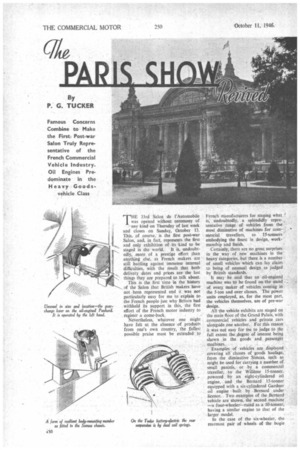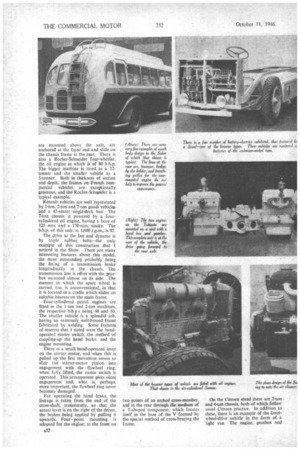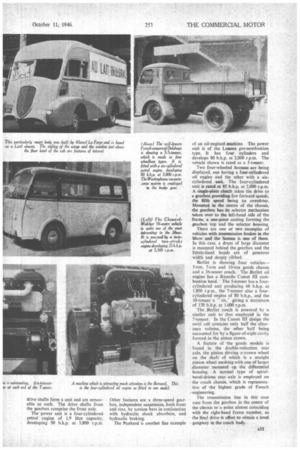By P. G. TUCKER
Page 32

Page 33

Page 34

Page 35

Page 36

If you've noticed an error in this article please click here to report it so we can fix it.
Famous Concerns Combine to Make the First Post-war Salon Truly Representative of the French Commercial Vehicle Industry. Oil Engines Predominate in the Heavy Goods vehicle Class
THE 33rd Salon de l'Automobile was opened without ceremony of any kind on Thursday of last week and closes on Sunday, October 13. This, of course, is the first post-war Salon, and, in fact, represents the first and only exhibition of its kind to be staged in the world. It is, undoubtedly, more of a prestige effort than anything else, as French makers are still battling against immense internal difficulties, with the result that both delivery dates and prices are the last things they are prepared to talk about.
This is the first time in the history of the Salon that British makers have not been represented and it was not particularly easy for me to explain to the French people just why Britain had withheld its support in this, the first effort of the French motor industry to register a come-back.
Nevertheless, whatever one might have felt at the absence of products from one's own country, the fullest possible praise must be extended to French manufacturers for staging what is, undoubtedly, a splendidly representative range of vehicles from the most diminutive of machines for commercial travellers, to 15-tonners embodying the finest in design, workmanship and finish.
Certainly, there are no great surprises in the way of new machines in the heavy categories, but there is a number of small vehicles which can lay claim to being of unusual design as judged by British standards.
It may be said that an oil-engined machine was to be found on -the stand . of every maker of vehicles corning in the 5-ton and over classes. The power units employed, as. for the most part, the vehicles themselves, are of pre-war design.
All the vehicle exhibits are staged on the main floor of the Grand Palais, with commercial. vehicles and private cars alongside one another. For this reason it was not easy for me to judge to the full extent the degree of interest being shown in the goods and passenger
machines. •
Examples of vehicles are displayed covering all classes of goods haulage. from the diminutive Simcas, such as might be used for carrying a number of small parcels, or by a commercial traveller, to' the Willtme 15-tonner. powered . by an eight-cylindered oil engine, and the Bernard 15-tonner equipped with a six-cylindered Gardner oil engine built by -Bernard under licence.. Two examples of the Bernard vehicle are shown, the second machine —a four-wheeler—rated as a 10-tonner, having a similar engine to that of the larger model.
In the case of the six-wheeler, the rearmost pair of wheels of the bogie are only load carriers, the drive being so the forward pair. A most noteworthy feature of both chassis is the immense depth of the frame, the deepest section being well towards the rear, and not in the centre of the wheelbase.
In addition to the chassis, the Bernard six-wheeler is exhibited as a tanker, the capacity of the light-alloy container being approximately 5,400 gallons, which makes the gross laden weight about 25 tons.
The Willeme, too, is a splendid example of French engineering. It is shown in three types—a 15-ton sixwheeler, a 10-ton six-wheeler and as a four-wheeler also rated as a 10-tonner.
The respective power units which, as previously mentioned, are oilers, have eight, six and four cylinders, the main components, such as cylinders, pistons and connecting rods, being identical in all three. The bore and stroke are 130 mm. by 170 mm., the b.h.p. per
cylinder being 25. Thus, the eightcylindered unit gives 200-225 b.h.p. at 1,600 r.p.m., the "six " 150 b.h.p. and the " four " 100 b.h.p. at the same r.p.m.
On all models eight forward speeds are provided by a four-speed box in. conjunction with an auxiliary box.
The four wheels of the bogie on the eight-cylinder six-wheeler are driven, whilst only the foremost pair of wheels on the six-cylinder six-wheeler are driven. On all models the driven axles are of the overhead-worm type and needle-roller universal joints are general in the transmission.
In keeping with several other machines in the heavy class, the Willeme has a ratchet-wheel type of hand-brake gear. The rear wheels incorporate the Michelin Bibax resilient mounting of the rear wheels to the hubs through the agency of rubber-bonded security bolts. Not only does this cushion the drive, but the effect of road camber is counteracted to afford more or less equal load distribution on all -wheels.
This system of rear-wheel mounting is also adopted by Berliet, Citroen, Latil, Panhard, Rochet-Schneider, Somua and Unic.
The Saurer concern is staging a 5-ton chassis powered by the well-known Saurer four-cylindered 80 b.h.p. oil engine. This unit is notable by reason of its clean design. The only auxiliary on the left-hand side is the dynamo, which is driven by twin belts from the crankshaft.
The tubular final-drive shaft to the rear axle is of exceptionally large diameter. Five forward speeds are provided, the fifth speed being an overdrive. A feature which I found only on the Saurer chassis was a fabric-type coupling at the base of the steering column.
All the heavy commercial vehicles appear to have helper springs at the rear. These are of the semi-elliptic type, mounted either directly above the main spring or, in some cases, above the axle when the main suspension is uriderslung.
On the Saurer the helper springs are above the axle and, under load, simply bear on the frame members.
On the six-wheeled, six-cylindered, oil-engined Rochet-Schneider, the helper springs, which, like those on the Saurer,
are mounted above the axle, are anchored at the frpnt end and slide on the chassis frame at the rear. There is also a Rochet-Schneider four-wheeler, the oil engine in which is of 80 b.h.p. The bigger machine is rated as a 12tanner and the smaller vehicle as a 5-tonner. Both in thickness of section and depth, the frames on French commercial vehicles are exceptionally generous, and the Rochet-Schnelder is a typical example.
Renault vehicles are well represented by I-ton, 2-ton and 7-ton goods vehicliis and a 43-seater 'single-deck bus. The 7-ton chassis is powered by a fourcylindered oil engine, having a bore of 125 mm. and a 170-mm. stroke. The b.h.p. of this unit, at 1,600 r.p.m., is 85.
The drive to the fan and dynamo is by triple rubber belts—the only example of this construction that I noticed in the Show. There are many interesting features about this model, the most outstanding probably being the fithng of a transmission brake longitudinally in the chassis. The transmission line is offset with the gearbox mounted almost on its side. The manner in which the spare wheel is carried, too, is unconventional, in that it is located in a cradle which slides on suitable bearers on the main frame.
Four-c-ylindered petrol engines are fitted in the 1-ton and 2-ton 'machines, the respective b.h.p.s being 48 and 50. The smaller vehicle is a splendid job. having an extremely well-braced frame fabricated by welding. Some features of interest that I noted were the handoperated starter switch, the method 'of coupling-up ihe hand brake, and the engine mounting.
There is a small hand-operated lever on the starter motor, and when this is pulled up the first movement serves to slide the starter-motor pinion into engagement with the fjywheel ring: when fully lifted, the motor switch is operated. This'arrangement gives silent engagement and, what is, perhaps, more important, the flywheel ring never becomes damaged.
For operating the hand brake, the linkage is taken from the end of the cross-shaft, transversely, so that the actual lever is on the right of the driver, the brakes being applied by pulling it upwards. Four point mounting is adopted for the engine: at the front on two points of an arched cross-inseinber, and at the rear through the vandians of a T-shaped component, which locates, itself in the base of the V formed by the special method of cross-bracing the frame. On the Citroen stand there are 2-ton send 4-ton chassis, both of which follow usual Citroen practice. In addition to these, there is an example of the frontwheel-drive vehicle in the form of a light van. The engine, gearbox and drive shafts form a unit and are removable as such. The drive shafts from the gearbox comprise the front axle.
The 'power unit is a four-cylindered petrol engine of L9 litre capacity. developing 50 b.h.p. at 3,800 r.p.m.
Other features are a three-speed gearbox, independent suspension, both front and rear, by torsion bars in conjunction with hydraulic shock absorbers, and hydraulic braking.
The Panhard is another fine example of an oil-engined machine. The power unit is of the Lanova pre-combustion type. It has four cylinders and develops SO b.h.p. at 2,000 r.p.m. The vehicle shown is rated as a 5-loaner.
Two four-wheeled Sonatas are being displayed, one having a fout-cylindered oil engine and the other with a sixcylindered wit. The four-cylindered unit is rated at 85 b.h.p. at 2,000 r.p.m. A iingle-plate tint& takes the drive to a itscarbox providing five forward speeds, the fifth speed being an overdrive. Mounted in the centre of the chassis. the gearbox has its selector mechanism taken over to the left-hand side of the frame, a one-piece casting forming the gearbox top and the selector housing.
There are one or two examples of vehicles with transmission brakes ai the Show and the Sonma is one of them. In this case, a dnim of large diameter is mounted behind the gearbox and the fabric-lined bands are of generous width and deeply ribbed.
Berliet is showing four vehicles5-ton. 7-ton and 10-ton goods chassis and a 36-seater coach. The Berliet oil engine has a Ricardo Cornet III combustion head. The 5-tonner has a fourcylindered unit producing 68 b.h.p. at 1.800 r.p.m.. the 7-tonner also a fourcylindered engine of 80 b.h.p., and the 10-tonner a 'six," giving a maximum of 120 b.h.p. at 1.600 r.p.m.
The Berliet coach is powered by a similar unit to that employed in the 7-touner. in the Comet III design the swirl cell contains only half the clearance volume, the other half being accounted for by a figure-of-eight cavity formed in the piston crown.
A feature of the goods models is found in the double-reduction rear axle, the pinion driving a crown wheel on the shaft of which is a straight pinion wheel meshing with one of larger .diameter mounted op the differential housing. A normal type of spiralbevel-driven rear axle is employed on the coach chassis, which is representative of the highest grade of French engineering.
The transmission line in this case runs from the gearbox in the centre of the chassis to a point almost coinciding with the right-hand frame member, as the final drive is offset to obtain a level gangway in the coach body.
The Chenarcl and Walcker concern is showing a small passenger vehicle, the chassis of which is interesting in that a little twin-cylindered two-stroke engine is used in conjunction with a three-speed gearbox, and the drive is to the front wheels.
Despite the short length of the crankshaft, it is supported on three doubleroller bearings. The engine works on the crankcase-compression principle and is, in general, of orthodox design. It is, however, mounted on its side, the beltdriven dynamo being held down to a pillar-casting bolted to the crankcase.
The only plain bearings in the assembly are the small ends of the connecting rods, as the big ends are of the roller-bearing type. Rated as a 6 h.p. unit, the maximum output is given as 25 b.h.p. at 3,500 r.p.m. Multiple torsion bars form the suspension system, with hydraulic shock absorbers in front. Although shown as a passenger machine, it is available as a van, in which form its rated payload is 30 cwt.
One of the smallest vehicles in the Show is the Tudor electric, which is noteworthy by reason of the fact that its complete foundation is comprised of four light-alloy castings of generous dimensions. The motor is mounted forward of the rear axle, which is independently sprung on dual coil springs. At the front, two semi-elliptic springs, mounted transversely, are employed. The total amperage of the batteries carried is 260 and the motor works on 4S volts.
As a goods carrier the rating is approximately 5 cwt. -Incidentally, the
Tudor is being marketed as a pleasure car and examples of it in this form are also shown.
An example of a battery-driven electric incorporating a normal type of three-speed gearbox is to be found in the Milde Krieger. It was pointed out that the electrical losses with the usual system were considered as high. if not higher, than the mechanical losses with a gearbox, hence the exploitation of the system. The vans shown have 15-cwt. payload ratings. As the batteries employed are of the cadmium-nickel type, a high degree of efficiency is to be expected in this direction.
Two other makes of battery-electric vehicle shown are the Sovel and Vetra, both of the heavy goods type.
(To be concluded)




































































